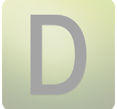|
We’re going to a look at some of the characteristics of layers, and then work with them and apply some behaviors to them. |
| Introduction |
|
Layers are squares that can be placed wherever you want in the Page, we can insert HTML content in them. Those layers can be hidden and overlapped between them. This gives you a great variety to design. |
|
Layers can be moved from their positions by just clicking on the the white square in its lerft top corner, and whilst keeping the mouse pressed, dragging it to the new position. They can also can be resized by clicking on the black squares and dragging them until the size you want is reached. |
 |
|
You can insert text, tables, images, and flash animations inside the layer’s square, and also all the elements that an HTML file can contain. This icon
|
| Inserting a layer |
|
Layers can be inserted in a Page through the Insert menu, and then selecting the Design object option, and Layer. Once the layer is inserted, you can edit its attributes by selecting it. You can select layers through many different ways. One of them is clicking on the |
|
When there are many layers in the same file, it’s recommendable to select them through the Layers tab in the Design panel, which can be opened through theWindow menu, and then the Layers option. If the Layers option isn’t in the menu, it may possibly be in the Others option. Also, it can be opened just by pressingF2. In the panel are the names of all existing layers in the actual file, and you only need to click on the layer name to select it. |
 |
| Layer format |
|
Layer’s properties are shown through its properties inspector  Layer ID is the layer’s name. You can change it through the Layers panel, and double-clicking it. L and T indicate the pixels distance between left and top limits of the document and the layer. W and H indicate the layer’s width and the height. Z-Index is the depth order of the layer. This value can be changed through the Layers panel. A layer will be overlapped by others which greater Z-index. Vis indicates the inital view of the layer. Visibility can accept four types.
You can also change the view through the Layers panel by clicking on the eye image. The open eye indicates Visible, and the closed eye indicates Hidden. Through Bg Image and Color you can indicate an image or a background color for the layer. Overflow controls how the layers appear in a browser when the content exceeds the specified size of the layer.
|
